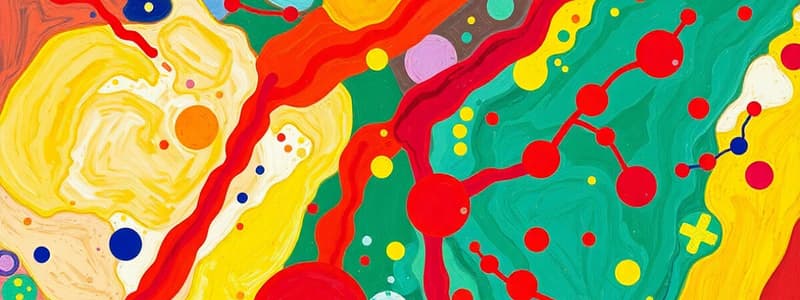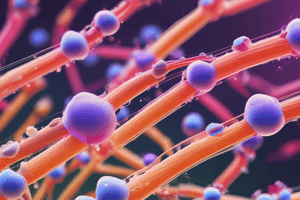Podcast
Questions and Answers
Which characteristic distinguishes hyaluronic acid from other glycosaminoglycans (GAGS)?
Which characteristic distinguishes hyaluronic acid from other glycosaminoglycans (GAGS)?
- It is non-sulfated. (correct)
- It contains up to 50,000 disaccharide units.
- It has covalently bound disaccharides.
- It is made up of GlcNAc and GICA.
What is a primary cause of Hurler's syndrome?
What is a primary cause of Hurler's syndrome?
- Accumulation of heparan sulfate.
- X-linked inheritance pattern.
- Deficiency of N-acetyltransferase.
- Deficiency of alpha-L-iduronidase. (correct)
Which of the following features is NOT characteristic of Dysotosis Multiplex?
Which of the following features is NOT characteristic of Dysotosis Multiplex?
- Excessive growth and no mental retardation. (correct)
- Lipid-like substance deposition in tissues.
- Abnormal facial features.
- Severe developmental abnormalities in cartilage.
How does Hunter syndrome differ from Hurler's syndrome?
How does Hunter syndrome differ from Hurler's syndrome?
Which statement accurately describes Sanfilippo syndrome?
Which statement accurately describes Sanfilippo syndrome?
Which glycosaminoglycan is unique for lacking uronic acid in its structure?
Which glycosaminoglycan is unique for lacking uronic acid in its structure?
What is the primary role of chondroitin sulfate in cartilage?
What is the primary role of chondroitin sulfate in cartilage?
Which of the following statements about heparin is correct?
Which of the following statements about heparin is correct?
Which glycosaminoglycan serves a key function in maintaining corneal transparency?
Which glycosaminoglycan serves a key function in maintaining corneal transparency?
What is the main function of hyaluronic acid in the joints?
What is the main function of hyaluronic acid in the joints?
What is the significance of the highly hydrated structure of hyaluronic acid?
What is the significance of the highly hydrated structure of hyaluronic acid?
Which of the following is true about dermatan sulfate?
Which of the following is true about dermatan sulfate?
What is the enzyme defect associated with Mucopolysaccharidosis I (Hurler Syndrome)?
What is the enzyme defect associated with Mucopolysaccharidosis I (Hurler Syndrome)?
Which glycosaminoglycan is primarily involved in the structure of the extracellular matrix?
Which glycosaminoglycan is primarily involved in the structure of the extracellular matrix?
Which glycosaminoglycans are primarily accumulated in Mucopolysaccharidosis II (Hunter Syndrome)?
Which glycosaminoglycans are primarily accumulated in Mucopolysaccharidosis II (Hunter Syndrome)?
Which of the following is a characteristic of keratan sulfate II?
Which of the following is a characteristic of keratan sulfate II?
What distinguishes hyaluronidase in its function?
What distinguishes hyaluronidase in its function?
What is the primary characteristic of Sanfilippo Syndrome?
What is the primary characteristic of Sanfilippo Syndrome?
Which enzyme deficiency causes Morquio Syndrome?
Which enzyme deficiency causes Morquio Syndrome?
Which of the following is NOT a symptom associated with Hurler Syndrome?
Which of the following is NOT a symptom associated with Hurler Syndrome?
In the context of cancer, how does hyaluronic acid contribute to tumor spread?
In the context of cancer, how does hyaluronic acid contribute to tumor spread?
What characterizes the structural aspect of glycosaminoglycans (GAGs)?
What characterizes the structural aspect of glycosaminoglycans (GAGs)?
Which syndrome is characterized as an X-linked disorder?
Which syndrome is characterized as an X-linked disorder?
The primary defect in Mucopolysaccharidosis VI (Maroteaux-Lamy's Syndrome) affects which enzyme?
The primary defect in Mucopolysaccharidosis VI (Maroteaux-Lamy's Syndrome) affects which enzyme?
What underlying issue leads to the symptoms of chondrodystrophies?
What underlying issue leads to the symptoms of chondrodystrophies?
Which of the following correctly describes the structure of glycosaminoglycans?
Which of the following correctly describes the structure of glycosaminoglycans?
Which of the following is NOT a type of mucopolysaccharidosis?
Which of the following is NOT a type of mucopolysaccharidosis?
What is a characteristic symptom of Hurler syndrome?
What is a characteristic symptom of Hurler syndrome?
Which glycosaminoglycan is typically associated with lubrication in joints?
Which glycosaminoglycan is typically associated with lubrication in joints?
What is a common physical symptom seen in Sanfilippo syndrome?
What is a common physical symptom seen in Sanfilippo syndrome?
Which of the following details is true about Hunter syndrome?
Which of the following details is true about Hunter syndrome?
What is the primary role of glycosaminoglycans in connective tissues?
What is the primary role of glycosaminoglycans in connective tissues?
What kind of enzymes are responsible for the degradation of glycosaminoglycans?
What kind of enzymes are responsible for the degradation of glycosaminoglycans?
Which of the following accurately describes an outcome of hereditary enzyme deficiencies related to mucopolysaccharidoses?
Which of the following accurately describes an outcome of hereditary enzyme deficiencies related to mucopolysaccharidoses?
What are the repeating units that constitute the structure of glycosaminoglycans?
What are the repeating units that constitute the structure of glycosaminoglycans?
Which type of glycosaminoglycan is primarily involved in the structural composition of cartilage?
Which type of glycosaminoglycan is primarily involved in the structural composition of cartilage?
What is a common characteristic of Hurler syndrome?
What is a common characteristic of Hurler syndrome?
Which enzyme deficiency is associated with Hunter syndrome?
Which enzyme deficiency is associated with Hunter syndrome?
Which of the following symptoms is NOT typically associated with Sanfilippo syndrome?
Which of the following symptoms is NOT typically associated with Sanfilippo syndrome?
Which type of glycosaminoglycan is NOT commonly found in the extracellular matrix?
Which type of glycosaminoglycan is NOT commonly found in the extracellular matrix?
What is the main biochemical function of glycosaminoglycans within the extracellular matrix?
What is the main biochemical function of glycosaminoglycans within the extracellular matrix?
Which type of glycosaminoglycan is significant for its ability to bind large amounts of water?
Which type of glycosaminoglycan is significant for its ability to bind large amounts of water?
Flashcards
Glycosaminoglycans (GAGs)
Glycosaminoglycans (GAGs)
Long, unbranched polysaccharide chains with repeating disaccharide units (sugar + sugar).
GAG Structure
GAG Structure
Repeating disaccharide units of uronic acid and glycosamine, forming long chains.
GAG Function
GAG Function
GAGs bind water to form a gel-like matrix supporting surrounding cells.
Extracellular Matrix (ECM)
Extracellular Matrix (ECM)
Signup and view all the flashcards
ECM Composition
ECM Composition
Signup and view all the flashcards
Proteoglycan
Proteoglycan
Signup and view all the flashcards
Uronic Acid
Uronic Acid
Signup and view all the flashcards
Glycosamine
Glycosamine
Signup and view all the flashcards
Chondroitin Sulfate Function
Chondroitin Sulfate Function
Signup and view all the flashcards
Keratan Sulfate Types
Keratan Sulfate Types
Signup and view all the flashcards
Heparin's Role
Heparin's Role
Signup and view all the flashcards
Dermatan Sulfate Location
Dermatan Sulfate Location
Signup and view all the flashcards
Heparan Sulfate Location
Heparan Sulfate Location
Signup and view all the flashcards
Hyaluronic Acid Composition
Hyaluronic Acid Composition
Signup and view all the flashcards
Hyaluronic Acid Function
Hyaluronic Acid Function
Signup and view all the flashcards
Hyaluronic Acid Structure
Hyaluronic Acid Structure
Signup and view all the flashcards
GAG Anticoagulant
GAG Anticoagulant
Signup and view all the flashcards
GAG roles in tissues
GAG roles in tissues
Signup and view all the flashcards
What are Glycosaminoglycans?
What are Glycosaminoglycans?
Signup and view all the flashcards
What are Glycosaminoglycans made of?
What are Glycosaminoglycans made of?
Signup and view all the flashcards
What are some examples of Glycosaminoglycans?
What are some examples of Glycosaminoglycans?
Signup and view all the flashcards
What is the function of Glycosaminoglycans?
What is the function of Glycosaminoglycans?
Signup and view all the flashcards
How do Glycosaminoglycans bind water?
How do Glycosaminoglycans bind water?
Signup and view all the flashcards
What are the effects of Glycosaminoglycan deficiency?
What are the effects of Glycosaminoglycan deficiency?
Signup and view all the flashcards
What are Mucopolysaccharidoses?
What are Mucopolysaccharidoses?
Signup and view all the flashcards
What are some symptoms of Mucopolysaccharidoses?
What are some symptoms of Mucopolysaccharidoses?
Signup and view all the flashcards
What are some examples of Mucopolysaccharidoses?
What are some examples of Mucopolysaccharidoses?
Signup and view all the flashcards
How are Mucopolysaccharidoses diagnosed?
How are Mucopolysaccharidoses diagnosed?
Signup and view all the flashcards
Hyaluronidase
Hyaluronidase
Signup and view all the flashcards
Hyaluronic Acid vs. Other GAGs
Hyaluronic Acid vs. Other GAGs
Signup and view all the flashcards
Mucopolysaccharidoses (MPS)
Mucopolysaccharidoses (MPS)
Signup and view all the flashcards
Hurler's Syndrome
Hurler's Syndrome
Signup and view all the flashcards
Hunter's Syndrome
Hunter's Syndrome
Signup and view all the flashcards
Enzyme deficiency
Enzyme deficiency
Signup and view all the flashcards
GAG accumulation
GAG accumulation
Signup and view all the flashcards
Hurler Syndrome (MPS I)
Hurler Syndrome (MPS I)
Signup and view all the flashcards
Hunter Syndrome (MPS II)
Hunter Syndrome (MPS II)
Signup and view all the flashcards
Sanfilippo Syndrome (MPS III)
Sanfilippo Syndrome (MPS III)
Signup and view all the flashcards
Morquio Syndrome (MPS IV)
Morquio Syndrome (MPS IV)
Signup and view all the flashcards
Lysosomal storage diseases
Lysosomal storage diseases
Signup and view all the flashcards
Hyaluronic acid
Hyaluronic acid
Signup and view all the flashcards
Study Notes
Extra Cellular Matrix (ECM)
- ECM is a collection of extracellular molecules secreted by cells.
- It provides structural and biochemical support to surrounding cells.
- The composition of ECM varies between multicellular structures.
- ECM functions include cell adhesion and cell-to-cell communication.
Glycosaminoglycans (GAGs)
- GAGs are large complexes of negatively charged heteropolysaccharide chains.
- They have a high water-binding capacity, forming a gel-like matrix.
- GAGs act as a cushion against mechanical shock.
- GAGs help lubricate joints.
- GAGs provide flexibility (elasticity) to cartilage.
Composition of ECM
- ECM is a mesh of fibrous proteins and GAGs.
- Major classes of biomolecules in ECM include:
- Structural proteins (collagen, elastin, fibrillin)
- Specialized proteins (fibronectin, laminin, fibrillin)
- Proteoglycans (proteins bonded to mucopolysaccharides)
Functions of ECM
- Binding and packing of tissues (connective tissue proper).
- Connecting, anchoring and supporting the body and its organs.
- Transport of metabolites between capillaries and tissues.
- Essential for processes like growth, wound healing, and fibrosis (scarring).
- Defense against infection (via ground substance and cells).
- Repair of injury (via cell proliferation and fiber formation).
- Fat storage.
Classification of GAGs
- Sulfate-free GAGs (e.g., hyaluronic acid)
- Sulfate-containing GAGs (e.g., chondroitin sulfate, keratan sulfate, heparin, heparan sulfate, dermatan sulfate)
Structure of GAGs
- Linear polymers.
- Heteropolysaccharide composed of repeating disaccharide units.
- Uronic acid and glycosamine are the repeating units in most GAGs.
Hyaluronic Acid
- A sulfate-free GAG.
- Contains D-glucouronic acid and N-acetylglucosamine.
- Forms a viscous, clear solution ideal for lubrication.
- Important for structural support in tissues.
- Plays a role in cell migration and wound repair.
- Found in synovial fluid, vitreous humor, and connective tissues.
Mucopolysaccharidoses (MPS)
- Rare inborn errors in the degradation of GAGs.
- Hereditary disorders (often autosomal recessive).
- Result in the accumulation of GAGs in various tissues.
- MPS lead to a range of symptoms including skeletal and extracellular matrix deformities, and mental retardation.
Dysotosis Multiplex
- Major features include severe abnormalities in the development of cartilage and bone.
- Significant skeletal changes and the deposition of a lipid-like substance in many body tissues.
- Often associated with mental retardation and organomegaly.
- Also characterized by abnormal facial features, hearing/vision and cardiovascular issues.
Disease related to abnormal GAGs
- This category covers conditions that arise from missing or insufficient GAG-breaking enzymes.
- These conditions often lead to the accumulation of GAGs in affected tissues, resulting in a range of symptoms.
Association of GAGs with cancer
- Tumor cells may exhibit increased production of hyaluronic acid, aiding in cell migration within ECM.
- Heparan sulfate may be less present on the surface of tumor cells, potentially impacting their adhesiveness.
Take Home Messages
- GAGs have a variety of functions related to lubrication, support, and cell interactions.
- Their accumulation or deficiency can cause serious diseases.
- Understanding the structure and function of GAGs is important for various medical fields.
Studying That Suits You
Use AI to generate personalized quizzes and flashcards to suit your learning preferences.
Related Documents
Description
This quiz covers the essential concepts of the extracellular matrix (ECM), including its composition, functions, and the role of glycosaminoglycans (GAGs). Learn how ECM provides support to cells and contributes to various physiological functions. Test your knowledge on structural proteins and the significance of these biomolecules in connective tissues.




